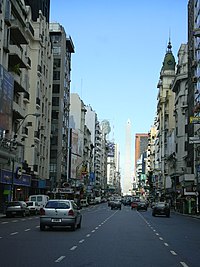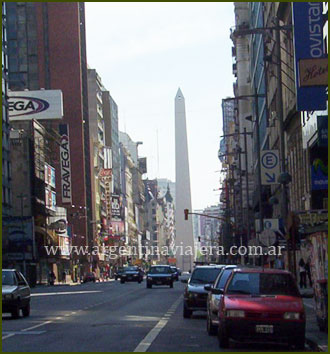Avenida Corrientes
The Corrientes Avenue is one of the main thoroughfares of the Argentine capital, Buenos Aires. The road is closely connected with the history of Tango Argentino and an identity for the porteños, so the inhabitants of Buenos Aires. It is also referred to as " street that never sleeps " and as " Broadway of Buenos Aires ." As the parallel streets Avenida Santa Fe, Av. Córdoba Av. San Juan has it. Named after an Argentine province
- 2.1 Once
- 2.2 Abasto
- 2.3 Almagro
- 2.4 Villa Crespo
Description
The Avenida Corrientes runs about 69 blocks (one block corresponds to approximately 110 meters ) from the Avenida Eduardo Madero in the eastern district of Puerto Madero direction west and northwest and ends on Avenida Federico Lacroze in the Chacarita neighborhood, taking a one-way street from West to East is. Line B subway runs for the most part below it.
The Asociación Amigos de la Calle Corrientes ( " Friends of the Avenida Corrientes ") is an association for the urban planning of the road. So far, she has had to install 40 street corners plaques, reminiscent of important figures of the tango.
History
In the 17th century it was called the street " del Sol ", 1738-1808 " San Nicolás " and 1808-1822 " Incháurregui " since bears the Avenida Corrientes its current name. Until the 19th century the street was only of average width. After the expansion of the city towards the west around 1880 traffic increased rapidly. 1887, the first horse-drawn tram on Avenida Corrientes was established, but this was insufficient for the needs soon. 1910 signed the Mayor Joaquín Samuel de Anchorena a law to widen the road.
The plan provided numerous demolitions of buildings on the north side of the road, which led to considerable resistance from affected property owners, retailers, but also by intellectuals like Roberto Arlt. However, a kind of coup d'état in 1930 paved the way for the implementation of the plan. In 1936 the work was completed. The grand opening of the "new " road coincided with the construction of the obelisk in the intersection with Avenida 9 de Julio, together, today one of the landmarks of the city. If today from Corrientes Avenue is spoken before the extension, the term " Corrientes Angosta " ( Narrow Corrientes ) is being used.
Attractions
- Luna Park, Sport and Event Centre
- Main Post Office
- Micro Centro financial center
- Pedestrian Florida Street
- Teatro Ópera and many other theaters
- The Obelisk of Buenos Aires on the intersection with Avenida 9 de Julio.
- Centro Cultural General San Martín
- La Plaza Complex, a private company with theaters and restaurants
Off- Corrientes
"Off - Corrientes " means (according to the "Off -Broadway " ), the alternative theater scene. Also includes the " Centro Ricardo Rojas ", which is known for his experimental art. It is located right on Avenida Corrientes.
Districts
The Corrientes Avenue crosses the following areas of Buenos Aires:
Once
This part of Balvanera is a formerly Jewish neighborhood, known for textile wholesale and retail, today also home to other nationalities, including Koreans and Peruvians.
Abasto
In the northwestern part of Balvanera, behind the Avenida Pueyrredón, the tango singer Carlos Gardel lived. A few years ago a rather dilapidated area, they now experienced a comeback. The name is derived from the former fruit and vegetable market, is housed in the now the largest shopping center of the city ( Abasto ).
Almagro
Almagro is a quiet residential area, characterized by multi-family homes. The center of the district is the intersection of Avenidas Medrano and Rivadavia.
Villa Crespo
Villa Crespo is another Jewish neighborhood. This plays a large part of the novel " Adán Buenosayres " by Leopoldo Marechal. Villa Crespo is also home of the football club Club Atlético Atlanta and Osvaldo Pugliese.
Corrientes in the tango music
The Avenida Corrientes is mentioned in many tango, the most popular being:
- A media luz by Carlos César Lenzi and Edgardo Donato
- Calle Corrientes by Alberto Vaccarezza and Enrique Delfino
- Corrientes angosta by Ángel " Pocho " Gatti
- Corrientes y Esmeralda by Celedonio Flores and Francisco Pracánico
- Tristezas de la calle Corrientes Homero Espósito and Domingo Federico, 1942
- Pucherito de gallina by Roberto Medina










